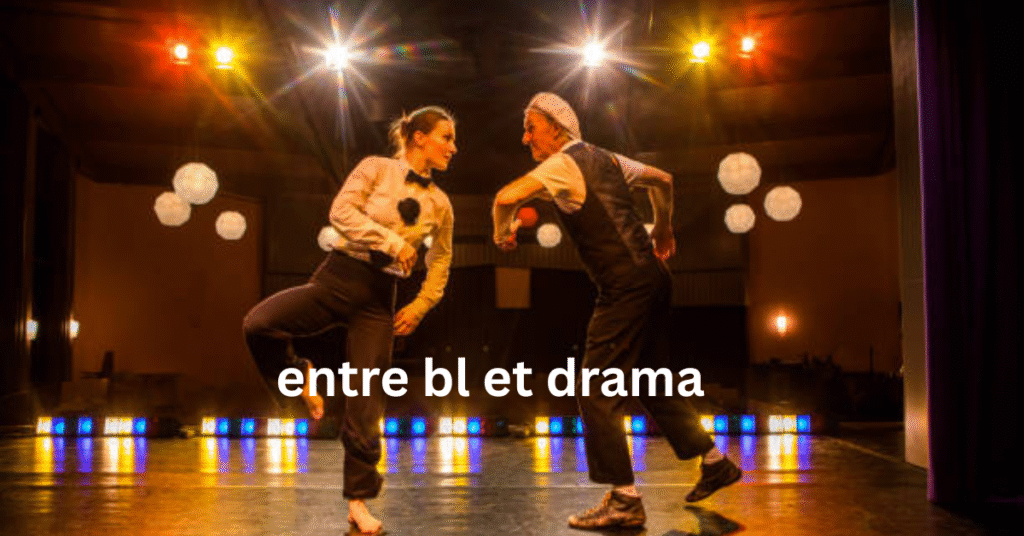When searching for “entre BL et Drama,” readers are often looking for clarity about the distinction and overlap between BL (Boys’ Love) and Drama (television or cinematic productions across genres). In simple words: BL refers to a category of stories focusing on romantic or emotional relationships between male characters, while “drama” encompasses a wider landscape of narrative media, including romance, thriller, historical, or family sagas. The question that often arises is—where does BL fit within drama, and how do the two interact? In the first hundred words, it is important to note: BL is not separate from drama, but rather a specialized narrative sub-genre thriving within dramatic storytelling. This guide will explain the differences, intersections, cultural meaning, and ongoing transformation of BL dramas in global entertainment.
What Does “Entre BL et Drama” Mean?
The phrase “entre BL et Drama” translates from French as “between BL and Drama.” This expression reflects the blurry boundaries where BL narratives are both distinct in theme yet rooted within the broader category of drama.
- BL (Boys’ Love): A genre originating in Japanese manga and anime, later adapted widely into television and film, focusing on male-male romantic or emotional relationships.
- Drama: A narrative medium, often serialized on television or produced as film, depicting conflicts, emotions, and character-driven stories.
Thus, when we speak of “entre BL et Drama,” we are describing the intersection: BL as a narrative style positioned within the greater umbrella of drama.
Historical Roots of BL
The BL genre began in Japan during the 1970s through shōjo manga, created by female artists for female readers. These works were inspired by a combination of Western literature, artistic experimentation, and cultural movements in Japan. BL stories provided a safe imaginative space where relationships could be explored outside the constraints of conventional gender roles.
As the genre expanded, BL transcended manga and anime, entering live-action adaptations and dramas. Thailand, South Korea, Taiwan, and China have all become major contributors to the global BL wave, each bringing local cultural sensibilities to the stories.
Drama as a Narrative Landscape
Drama, as a form, is not confined to romance. It may include historical sagas, workplace struggles, psychological thrillers, or family narratives. Drama is defined by its attention to emotional depth, conflict, and character development.
When BL is integrated into drama, it is not treated as a separate artistic experiment but as part of the larger storytelling universe. This means BL dramas can share space with traditional love stories, suspense plots, or period dramas—adding diversity to narrative traditions.
Key Differences Between BL and General Drama
| Aspect | BL (Boys’ Love) | General Drama |
| Audience | Traditionally female, though now broadening to all genders and orientations | Wide demographic, genre-specific audiences |
| Central Theme | Romantic/emotional relationships between male characters | Varies—romance, thriller, historical, social, political, family |
| Cultural Origin | Rooted in Japanese manga and anime, expanded globally | Global, developed independently in different countries |
| Representation | Focused on queer male relationships | Varies, may or may not include LGBTQ+ themes |
| Narrative Style | Often idealized romance, though modern BL includes realism | Realism, heightened emotion, or genre-based storytelling |
The Rise of BL Dramas in Asia
In recent years, BL dramas have flourished, especially in Thailand, South Korea, and Taiwan. Titles like “SOTUS” (Thailand), “Semantic Error” (South Korea), and “HIStory” (Taiwan) have gained international followings.
These productions demonstrate that BL is no longer niche. Streaming platforms allow fans worldwide to access shows, contributing to a rapidly expanding fandom.
Why Audiences Connect With BL Dramas
There are several reasons why BL dramas resonate strongly with viewers:
- Romantic Idealism: BL often presents relationships with emotional purity, sincerity, and vulnerability, which feel refreshing in a world of often formulaic romance.
- Representation: For many LGBTQ+ viewers, BL dramas provide much-needed visibility, even when stories are created primarily for heterosexual female audiences.
- Cultural Curiosity: International fans are drawn to BL dramas for a glimpse into other cultures’ attitudes toward love, friendship, and identity.
- Community: Online fandoms around BL dramas are highly interactive, creating a sense of belonging and shared passion.
Cultural Criticisms and Challenges
Despite their popularity, BL dramas face critique:
- Idealization of Queer Lives: Critics argue that some BL stories romanticize relationships without acknowledging real-world struggles of LGBTQ+ people.
- Market-Driven Production: As demand grows, some dramas are produced quickly, sacrificing depth for commercial success.
- Censorship: In regions like China, strict regulations force BL adaptations to tone down or erase romantic elements, reducing authenticity.
Still, these challenges highlight the ongoing evolution of the genre, rather than diminishing its cultural importance.
BL Dramas and Global Streaming
Global platforms like Netflix, Viki, and YouTube have accelerated BL’s international reach. Subtitles, fan communities, and recommendations help BL dramas travel across borders in ways traditional dramas often do not.
This accessibility fosters new cultural conversations: How do different audiences interpret BL differently? What does its popularity say about shifting attitudes toward gender and sexuality?
BL vs. Drama: Intersection Rather Than Division
The important realization when considering “entre BL et Drama” is that BL is not separate—it is a type of drama. Just as crime, medical, or fantasy dramas exist, BL drama represents one of many thematic directions in storytelling. The distinction lies not in the medium but in the focus of the narrative.
The Role of Storytelling in BL and Drama
Both BL and drama rely heavily on emotional storytelling. What distinguishes BL is the choice of characters and relationships at the center. In many ways, BL adds richness to the tapestry of drama by bringing new perspectives, marginalized voices, and alternative expressions of love.
Current Trends in BL and Drama
- Darker Narratives: Moving away from pure romance, BL dramas are beginning to incorporate crime, mystery, and psychological elements.
- Increased Realism: Stories are portraying real struggles—family acceptance, societal pressure, and identity exploration.
- Cross-Cultural Production: International collaborations are creating BL dramas blending styles from multiple countries.
- Mainstream Integration: BL actors are crossing into mainstream dramas, and vice versa, breaking boundaries between genres.
Audience Evolution
The audience of BL dramas has changed significantly. While the early core was largely young women, today it is diverse:
- LGBTQ+ Viewers: Finding identity and visibility.
- Straight Audiences: Enjoying fresh storytelling.
- International Fans: Using BL as an entry point to learn languages and cultures.
Comparative Analysis: BL and Non-BL Drama
| Feature | BL Drama | Non-BL Drama |
| Narrative Focus | Romantic/emotional male-male relationship | Varies—heterosexual romance, family, career, thriller |
| Representation | LGBTQ+ at the center | Often heterosexual-centric |
| Production Style | Shorter seasons, niche production companies | Wider budgets, large-scale productions |
| Audience Fandom | Highly active online communities | Broader but less concentrated fan interaction |
The Future of BL Within Drama
The trajectory suggests BL dramas will continue to integrate into mainstream television and film. Over time, the label “BL” may blur, giving way to a broader category of LGBTQ+ storytelling within drama.
The ultimate future may not be a division of “BL vs Drama,” but rather an inclusive drama landscape where all stories of love and conflict coexist equally.
Conclusion
“Entre BL et Drama” captures a dialogue about boundaries and intersections. BL is not a separate entity but a vibrant branch of dramatic storytelling that has reshaped entertainment globally. With its unique themes of love, vulnerability, and representation, BL contributes significantly to the richness of drama.
As global audiences grow more open, BL dramas will likely evolve further, transcending labels and merging into the shared universe of drama—where every story, regardless of gender or orientation, deserves a stage.
FAQs
1. What does “entre BL et Drama” mean?
It means “between BL and Drama,” referring to the relationship and overlap between Boys’ Love stories and broader dramatic storytelling.
2. Is BL considered a type of drama?
Yes, BL dramas are a sub-genre of drama, focused on male-male relationships but part of the wider drama category.
3. Why are BL dramas popular internationally?
They offer unique representation, romantic sincerity, and cultural insights, supported by global streaming access and active online fandoms.
4. How do BL dramas differ from traditional romance dramas?
BL focuses on LGBTQ+ relationships, while traditional dramas usually emphasize heterosexual love stories. The themes and tone can differ, too.
5. What is the future of BL dramas?
BL dramas are moving toward mainstream integration, with more realistic storytelling, cross-genre experiments, and broader cultural acceptance.







